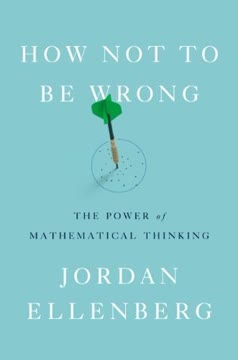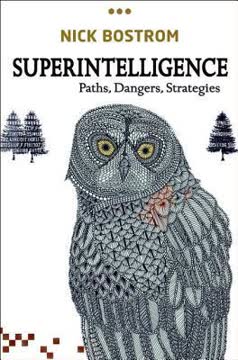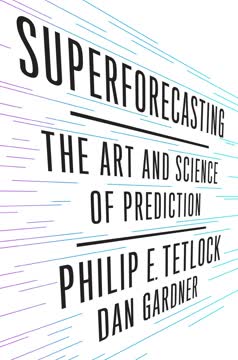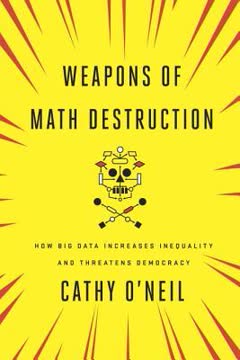Key Takeaways
1. Optimal Stopping: When to Commit in Life's Decisions
"The 37% Rule defines a simple series of steps—what computer scientists call an "algorithm"—for solving these problems."
The 37% Rule. This mathematical principle suggests that when faced with a series of options (like potential partners or job candidates) and needing to choose the best one, you should examine 37% of the options to establish a baseline, then choose the next option that's better than all those you've seen. This rule applies to various life decisions:
- Partner selection: If you plan to date between ages 18 and 40, the optimal time to start seriously considering a long-term partner is around age 26.
- House hunting: Look at 37% of available houses before making an offer.
- Parking: In a linear parking lot, start looking for a spot after passing 37% of the lot.
The rule balances the risks of stopping too early (missing out on better options) and stopping too late (having already passed the best option). While it doesn't guarantee success, it optimizes your chances of making the best choice given limited information.
2. Explore vs. Exploit: Balancing New Experiences and Favorites
"Exploration is gathering information, and exploitation is using the information you have to get a known good result."
The explore/exploit tradeoff. This concept addresses the tension between trying new things (exploring) and sticking with what we know works (exploiting). It's relevant in various aspects of life:
- Dining out: Try new restaurants or return to favorites?
- Career choices: Pursue a new field or deepen expertise in current one?
- Travel: Visit new destinations or return to beloved spots?
The optimal balance changes over time:
- Early in life: Focus more on exploration to gather information and experiences
- Mid-life: Gradually shift towards exploitation as you identify preferences
- Later in life: Lean more heavily into exploitation, enjoying known pleasures
Strategies for balancing:
- Upper Confidence Bound algorithm: Choose options with the highest potential upside
- Gittins index: Assign values to options based on their potential and uncertainty
- A/B testing in business: Systematically try new approaches while maintaining successful ones
3. Sorting: The Power and Limitations of Organizing Information
"Scale hurts."
Efficiency decreases with size. Sorting becomes exponentially more difficult as the amount of data increases. This principle applies to both computational and real-world sorting tasks:
- Digital sorting: Algorithms like Merge Sort and Quick Sort are designed to minimize this scaling problem
- Physical sorting: Organizing a small closet is much easier than a large warehouse
Key insights:
- The best sorting method depends on the specific situation and goals
- Perfect sorting is often unnecessary and can be counterproductive
- Sometimes, leaving things unsorted is more efficient (e.g., messy desk)
Real-world applications:
- Library organization: Balance between perfect order and usability
- Sports rankings: Different tournament structures (e.g., round-robin, brackets) offer trade-offs between accuracy and efficiency
- Personal organization: Recognize when "good enough" sorting is sufficient
4. Caching: Efficient Information Retrieval and Memory Management
"Caching plays a critical role in the architecture of memory, and it underlies everything from the layout of processor chips at the millimeter scale to the geography of the global Internet."
Optimize for frequent access. Caching involves storing frequently-used information in easily accessible locations. This principle applies to both computer systems and human behavior:
Computer caching:
- Multiple levels of cache (L1, L2, L3) in processors
- Content Delivery Networks (CDNs) for faster web access
- Browser caching for quicker page loads
Human caching:
- Keeping frequently used items within easy reach
- Organizing living spaces based on usage patterns
- Mental "caching" of important information
Key strategies:
- Least Recently Used (LRU): Remove the least recently accessed item when space is needed
- Temporal locality: Recently used items are likely to be used again soon
- Spatial locality: Items near recently used items are likely to be used soon
Caching in everyday life:
- Home organization: Keep daily items easily accessible
- Work efficiency: Arrange your desk for quick access to common tools
- Learning: Review important information periodically to keep it "cached" in memory
5. Scheduling: Optimizing Task Completion and Time Management
"If you followed the best possible process, then you've done all you can, and you shouldn't blame yourself if things didn't go your way."
Process over outcome. Effective scheduling is about implementing the best process, not just focusing on results. Key scheduling algorithms and their real-world applications include:
-
Earliest Due Date (EDD):
- Computer: Minimize maximum lateness
- Life: Tackle urgent deadlines first
-
Shortest Processing Time (SPT):
- Computer: Minimize average completion time
- Life: Knock out quick tasks to build momentum
-
Moore's Algorithm:
- Computer: Minimize number of late tasks
- Life: Strategically choose which deadlines to miss when overloaded
Practical scheduling strategies:
- Break large tasks into smaller, manageable chunks
- Use time-boxing techniques (e.g., Pomodoro) to maintain focus
- Build in buffer time for unexpected issues
- Regularly reassess and reprioritize tasks
Avoid common pitfalls:
- Thrashing: Switching tasks too frequently, reducing overall productivity
- Priority inversion: Low-priority tasks blocking high-priority ones
- Over-optimization: Spending more time planning than doing
Remember that perfect scheduling is often impossible due to uncertainty and changing circumstances. The goal is to implement a robust process that adapts to new information and constraints.
6. Bayes's Rule: Making Better Predictions with Limited Information
"Small data is big data in disguise."
Update beliefs with new evidence. Bayes's Rule provides a framework for making rational predictions based on limited information and updating those predictions as new data becomes available. This approach is valuable in various domains:
Applications of Bayesian thinking:
- Medical diagnosis: Updating disease probability based on test results
- Financial forecasting: Adjusting market predictions with new economic data
- Criminal investigations: Reassessing suspect likelihood as evidence emerges
Key Bayesian concepts:
- Prior probability: Initial belief before new evidence
- Likelihood: Probability of the evidence given the hypothesis
- Posterior probability: Updated belief after considering new evidence
Practical Bayesian strategies:
- Maintain an open mind to new information
- Seek out disconfirming evidence to challenge your beliefs
- Regularly update your predictions as new data becomes available
- Recognize the limits of your knowledge and express uncertainty
Bayesian thinking in everyday life:
- Dating: Update your assessment of compatibility as you learn more about a person
- Career decisions: Adjust your plans based on new experiences and feedback
- Consumer choices: Refine product preferences with each purchase and use
7. Overfitting: The Dangers of Overthinking and Overcomplicating
"Err on the side of messiness."
Simplicity often outperforms complexity. Overfitting occurs when a model or decision-making process becomes too complex, fitting noise in the data rather than underlying patterns. This concept applies to both machine learning and human decision-making:
Machine learning overfitting:
- Training data fit perfectly, but poor performance on new data
- Solution: Cross-validation, regularization techniques
Human overfitting:
- Overthinking decisions, leading to analysis paralysis
- Creating overly complex plans that fail in real-world conditions
Strategies to avoid overfitting:
- Embrace uncertainty and imperfect information
- Use simple heuristics for quick decision-making
- Periodically step back to assess the big picture
- Test ideas in small, low-risk scenarios before full implementation
Real-world examples of overfitting:
- Financial markets: Overly complex trading strategies that fail in changing conditions
- Project management: Excessively detailed plans that crumble upon first contact with reality
- Personal relationships: Overanalyzing social interactions, leading to awkwardness
Remember that the goal is to find the right level of complexity for the problem at hand, not to eliminate all uncertainty or imperfection.
8. Relaxation: Simplifying Complex Problems for Better Solutions
"If you can't solve the problem in front of you, solve an easier version of it—and then see if that solution offers you a starting point, or a beacon, in the full-blown problem."
Strategically simplify. Relaxation in computer science involves temporarily removing or simplifying constraints to make a problem more manageable. This approach can be applied to various real-world challenges:
Types of relaxation:
- Constraint Relaxation: Temporarily ignore certain rules or limitations
- Continuous Relaxation: Treat discrete choices as continuous variables
- Lagrangian Relaxation: Convert hard constraints into penalties
Benefits of relaxation:
- Provides a starting point for tackling complex problems
- Offers insights into the structure of the problem
- Can lead to "good enough" solutions when perfect solutions are impractical
Applying relaxation to everyday problems:
- Career planning: Start with an ideal scenario, then adjust for reality
- Budget optimization: Begin with unconstrained spending, then prioritize
- Creative projects: Brainstorm without limitations, then refine ideas
Examples of relaxation in action:
- City planning: Design an ideal city layout, then adapt to geographical constraints
- Product development: Envision a perfect product, then work within technological limitations
- Conflict resolution: Imagine an ideal outcome, then negotiate towards a realistic compromise
Remember that relaxation is a tool for generating ideas and starting points, not a replacement for dealing with real-world constraints. The key is to use the insights gained from the simplified version to inform your approach to the full problem.
9. Randomness: Harnessing Chance for Problem-Solving
"Sometimes the best solution to a problem is to turn to chance rather than trying to fully reason out an answer."
Embrace controlled chaos. Randomness can be a powerful tool for breaking out of local optima and finding innovative solutions. This principle applies in both computational and human problem-solving:
Computational uses of randomness:
- Simulated annealing: Gradually reducing randomness to find good solutions
- Genetic algorithms: Using random mutations to evolve better solutions
- Monte Carlo methods: Random sampling to estimate complex probabilities
Human applications of randomness:
- Creative brainstorming: Random word associations to spark new ideas
- Decision-making: Coin flips to break analysis paralysis
- Learning: Exploring random topics to broaden knowledge
Benefits of incorporating randomness:
- Overcomes cognitive biases and entrenched thinking patterns
- Explores a wider solution space, potentially finding unexpected solutions
- Provides a way to make progress when rational analysis fails
Strategies for harnessing randomness:
- Use random prompts or constraints in creative work
- Periodically introduce random elements into routines to avoid ruts
- Embrace serendipitous encounters and unexpected opportunities
Examples of productive randomness:
- Scientific discoveries: Accidental findings leading to breakthroughs
- Art and music: Experimental techniques producing innovative works
- Career paths: Unexpected detours leading to fulfilling opportunities
While randomness can be powerful, it's important to balance it with structured thinking and to recognize when precision is necessary. The goal is to use randomness as a tool, not to rely on it entirely.
10. Networking: Understanding and Optimizing Human Connections
"The message is simple but profound: if we're willing to accept solutions that are close enough, then even some of the hairiest problems around can be tamed with the right techniques."
Optimize connections, not just content. Networking principles from computer science offer insights into human social networks and communication:
Key networking concepts:
- Packet switching: Breaking messages into small, manageable pieces
- Routing protocols: Finding efficient paths for information flow
- Congestion control: Managing overload in communication channels
Applying networking principles to human interactions:
- Information sharing: Break complex ideas into digestible chunks
- Relationship building: Establish multiple
Last updated:
FAQ
What's Algorithms to Live By about?
- Exploration of decision-making: The book explores how algorithms from computer science can be applied to everyday human decisions, such as dating, apartment hunting, and scheduling.
- Interdisciplinary insights: Authors Brian Christian and Tom Griffiths blend computer science, psychology, and philosophy to provide a comprehensive view of decision-making.
- Practical applications: It offers strategies for optimizing choices in various scenarios, making complex concepts accessible to a broad audience.
Why should I read Algorithms to Live By?
- Enhance decision-making skills: The book provides tools and frameworks to improve decision-making in both personal and professional contexts.
- Engaging storytelling: The authors use relatable anecdotes and examples to make complex concepts engaging and easy to understand.
- Broader understanding of algorithms: It encourages critical thinking about how algorithms influence various aspects of life, from technology to social interactions.
What are the key takeaways of Algorithms to Live By?
- Optimal stopping: The "37% rule" suggests sampling 37% of options before making a decision to maximize the chances of selecting the best one.
- Explore/exploit tradeoff: The book discusses balancing exploration of new options with exploitation of known ones for effective decision-making.
- Bayesian reasoning: Emphasizes updating beliefs based on new evidence to refine decision-making processes.
What is the "37% rule" in Algorithms to Live By?
- Optimal stopping strategy: The rule suggests sampling 37% of options before making a decision to maximize the likelihood of selecting the best one.
- Mathematical foundation: Derived from probability theory, it provides a systematic approach to decision-making in uncertain situations.
- Real-life applications: Applicable to scenarios like choosing a partner, hiring employees, or selecting a job offer.
How does Algorithms to Live By explain the explore/exploit tradeoff?
- Balancing act: The tradeoff involves choosing between exploring new options and exploiting known ones, crucial for optimizing decisions.
- Epsilon-Greedy strategy: Suggests exploring new options a small percentage of the time while primarily exploiting the best-known choice.
- Practical implications: Helps in making better choices in contexts like investing, job searching, or social interactions.
How does Algorithms to Live By explain Bayesian reasoning?
- Updating beliefs: Bayes's Rule is used to update the probability of a hypothesis based on new evidence, refining decision-making processes.
- Practical applications: Applied in situations like medical diagnosis or predicting outcomes, helping make informed decisions.
- Cognitive implications: Encourages critical thinking and a nuanced approach to decision-making by considering both prior beliefs and new evidence.
What is the Secretary Problem in Algorithms to Live By?
- Optimal stopping scenario: Involves choosing the best candidate from a pool of applicants interviewed sequentially.
- 37% rule application: Reject the first 37% of candidates to establish a baseline, then select the next candidate better than all previously seen.
- Broader implications: Illustrates decision-making challenges under uncertainty and the mathematical principles guiding optimal choices.
What is overfitting and how does it relate to decision-making in Algorithms to Live By?
- Definition of overfitting: Occurs when a model is too complex, capturing noise rather than the underlying pattern in data.
- Impact on decisions: Can lead to poor decision-making by relying on overly complex models that don't generalize well.
- Strategies to avoid overfitting: Use simpler models and regularization techniques to make more robust choices in uncertain environments.
How does Algorithms to Live By address the concept of computational kindness?
- Definition of computational kindness: Designing systems and algorithms that reduce cognitive load and ease decision-making.
- Real-world examples: Applied in situations like restaurant seating policies or urban planning to enhance user experience.
- Broader implications: Encourages creating environments that support better decision-making with less mental effort.
What are some examples of algorithms discussed in Algorithms to Live By?
- Mergesort: Highlighted for its efficiency in organizing data, demonstrating the importance of sorting in computing and everyday life.
- Caching algorithms: Discussed for personal organization, emphasizing prioritizing frequently accessed items.
- Scheduling algorithms: Explored for optimizing time management and task completion in personal and professional contexts.
What does Algorithms to Live By say about scheduling?
- Single-machine scheduling: Explores managing tasks and deadlines, prioritizing based on due dates and task lengths.
- Optimal strategies: Presents algorithms like Earliest Due Date and Shortest Processing Time to enhance productivity.
- Real-world applications: Principles can be applied to everyday life, helping manage time and tasks effectively.
What are the best quotes from Algorithms to Live By and what do they mean?
- "The heart has its reasons that reason knows not.": Highlights the tension between emotional and rational decision-making.
- "Life is just too complicated for that.": Reflects the complexity of real-world decision-making, encouraging practical approaches.
- "Computational kindness isn’t just a principle of behavior; it’s also a design principle.": Advocates for user-friendly systems that facilitate better decision-making.
Review Summary
Algorithms to Live By receives mostly positive reviews for applying computer science concepts to everyday decision-making. Readers appreciate its insights into optimal strategies for common problems, though some find the mathematical explanations challenging. The book is praised for its engaging writing style and practical applications, but criticized by a few for oversimplification. Many reviewers highlight the book's unique approach to self-help through algorithmic thinking. Overall, it's recommended for both tech-savvy readers and those interested in improving decision-making processes.
Similar Books










Download PDF
Download EPUB
.epub digital book format is ideal for reading ebooks on phones, tablets, and e-readers.





